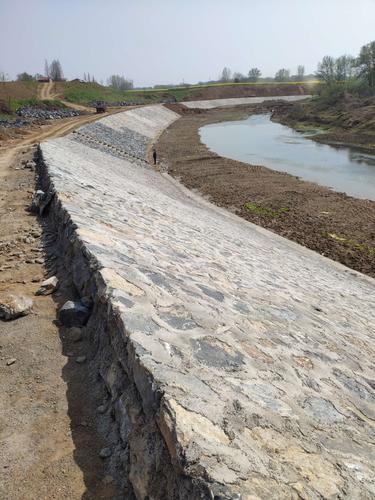|
tone pitching is an important method of slope protection involving the artificial stacking of stones which can not only effectively prevent soil erosion but also enhance the stability of the slope surface protect the environment and road safety.
In urban construction water conservancy environmental protection and transportation facilities stone pitching is widely used due to its economic aesthetic and environmental advantages.
This article will provide a detailed introduction to the technical principles material selection design considerations and construction methods of stone pitching.

Technical principles of stone masonry slope protection
Stone pitching is achieved by constructing selected stone materials on a slope according to certain techniques and methods to stabilize the soil, drain surface water, and beautify the environment.
The main principle is to utilize the weight and interlocking spaces of the stones to resist erosion by external factors on the slope surface, and to reduce soil erosion by water flow through the friction and interlocking between the stones.
At the same time, the voids created by stone pitching allow for plant growth, further reinforcing the slope surface and forming an ecological pitching.
II. Material selection for stone masonry slope protection
The stone materials for constructing stone retaining walls typically need to possess good natural stability durability and sufficient compressive strength.
Commonly used stones include granite limestone basalt etc.
When selecting materials the specifications and shapes of the stones must also be considered generally recommending the use of irregular large stone blocks which can better interlock and stabilize the slope surface.
In addition to ensuring the quality and practicality of the project appropriate stone materials should be selected based on the climatic conditions and environmental characteristics of the region.
III. Design considerations of stone masonry slope protection
When designing the stone masonry slope, the following technical points must be considered:
1. Slope and height: The slope and height directly affect the stability of the slope protection and the amount of materials used.
The slope should not be too steep, usually between 1:1.5 (vertical: horizontal) and 1:3.
2. Drainage system design: A good drainage system is the key to ensure the stability of the slope.
When designing, drainage ditches and stone holes should be reasonably set up to discharge water from the slope surface and the backside.
3. Soil analysis: The study of soil type and condition is of guiding significance to the stability, design and construction mode of stone masonry slope.
4. Vegetation combination: According to the regional climate and environment, the appropriate vegetation should be selected for combination, which can not only beautify the environment, but also enhance the stability and ecological benefits of the slope protection.
Construction methods of stone masonry slope
The construction of stone retaining wall usually includes the following steps:
1. Site preparation: Clear weeds, tree roots and loose soil on the slope to keep it dry and firm.
2. Laying the base: lay a layer of rough stones as the foundation to ensure good drainage.
3. Layer by layer masonry: According to the design drawings, stones are built layer by layer, and small stones are used between each layer to fill the gaps and increase the overall stability.
4. Drainage and fixation: During the construction process, pay attention to leaving enough space between the stones as drainage channels, and use wire or fabric materials to fix the stones to prevent sliding.
5. Vegetation restoration: After construction, herbaceous plants or shrubs are planted in the crevice according to the design, which can not only beautify the environment, but also help to fix the soil on the slope.
V. Maintenance and monitoring of stone masonry slope
Although stone masonry retaining walls have good stability they also require regular maintenance and monitoring due to long-term exposure to natural environments.
Routine maintenance includes checking vegetation growth looseness of stone blocks and drainage system conditions and making corresponding repairs.
Through regular maintenance the service life of the retaining wall can be effectively extended and its protective function ensured.
In summary, stone masonry retaining walls are an economical, practical, aesthetically pleasing, and environmentally friendly slope protection method.
Correct design, reasonable material selection, standardized construction, and regular maintenance are all key factors in ensuring the long-term stability of stone masonry retaining walls.
Through this article's introduction, it is hoped that it will provide useful references and guidance for engineering technicians and environmental protectors in relevant fields.
|